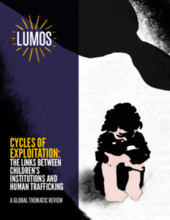LUMOS has launched a ground-breaking new report: Cycles of Exploitation: The Links Between Children’s Institutions and Human Trafficking. The report makes recommendations for breaking the complex cycles of exploitation that trap children and let traffickers go free. These include better data collection so that children do not slip through cracks in the system, the reinvestment of funding from institutions into family and community-based services, and a new model law, drafted by award-winning human rights barrister Parosha Chandran, that aims to stamp out institution-related trafficking.
This first-of-its-kind report brings together unique case studies and research from across the world to reveal four different cycles of trafficking in which orphanages and other institutions play a central connecting role. It exposes the global patterns of institution-related trafficking where children are trafficked both into and out of institutions and exposed to multiple forms of exploitation and harm.
Although the link between children’s institutions and human trafficking was recognised by the United Nations General Assembly in 2019, there are few examples of it being effectively tackled.
Millions of children worldwide continue to be exposed to institution-related human trafficking.
The report also casts spotlights on three key factors that drive institution-related trafficking:
- Funding for institutions
- Orphanage tourism and volunteering (‘voluntourism’)
- Migrant and refugee children being left unaccompanied.
As the refugee crisis escalates, the wheels of the tourism industry begin to turn again, and as humanitarian disasters continue to drive misplaced philanthropy, the report calls for immediate action to break these harmful cycles of exploitation and to protect vulnerable children across the globe.

